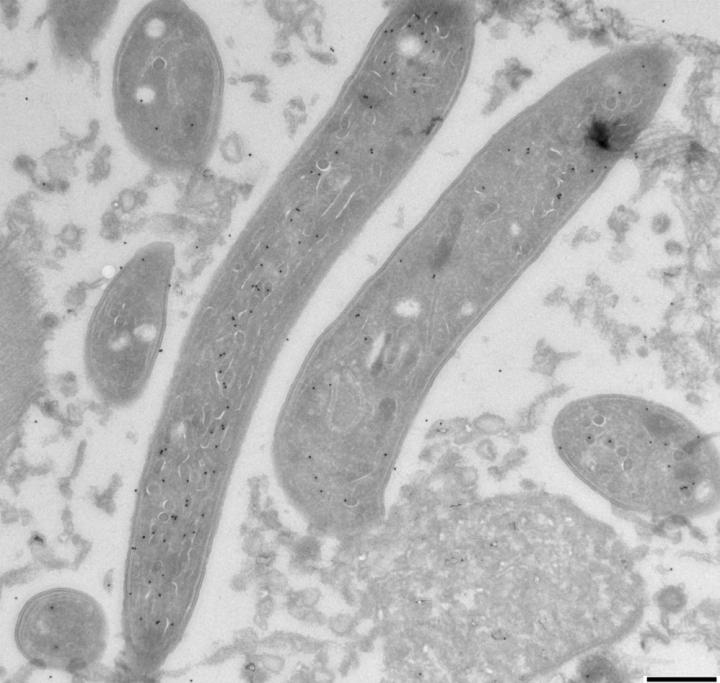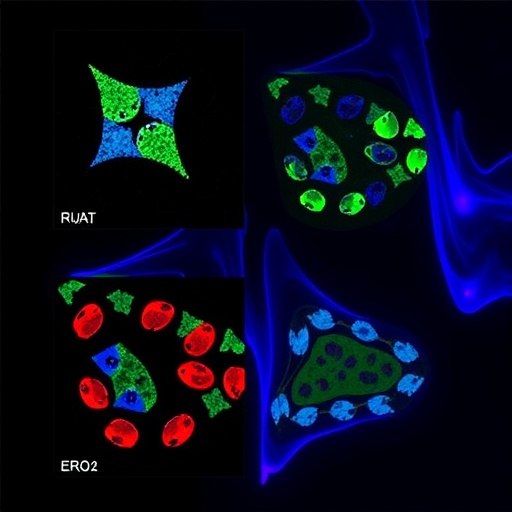New study shows how Plasmodium enters hepatocytes

Credit: Andreia Pinto, Comparative Pathology Unit iMM.
A new study led by Maria Manuel Mota, group leader at Instituto de Medicina Molecular João Lobo Antunes (iMM; Portugal), now shows that malaria parasites secrete the protein EXP2 that is required for their entry into hepatocytes. These findings, published today in the scientific journal Nature Communications*, open a new avenue for prophylactic anti-malarial strategies, since blocking or decreasing the infection of the liver can prevent the disease.
Plasmodium parasites are the causative agents of malaria, one of the most prevalent infectious diseases, that still infect yearly over 200 million people worldwide. After being transmitted, Plasmodium parasites travel to the liver, where they infect its cells, called hepatocytes. It is still largely unknown how parasites invade hepatocytes and consequently, few therapies are available to prevent this initial step. Now, a research team led by Maria Manuel Mota at iMM has discovered that these parasites secrete a protein named EXP2, before invading the hepatocyte, creating pores in the host cell’s membrane. “We observed that the Plasmodium parasites, that are called sporozoites at this stage, secrete EXP2 molecules before entering the cell and this protein creates pores in the outer membrane of hepatocytes, facilitating parasite entry. If you image the hepatocyte as a house, the parasites are breaking window- in this case with the EXP2 proteins – to trigger the alarm system of the hepatocytes”, explains João Mello-Vieira, PhD student and first author of this work.
EXP2 had been widely studied during the blood stage of infection, where it has a crucial role only after the parasite has established itself inside the red blood cell. However, its role during the liver infection was unclear. Vanessa Zuzarte Luis, senior author of the work explains: “We observed that sporozoites that lack EXP2, are not able to invade hepatocytes. But, if we produce this protein and add it to the cells, the parasites that lack EXP2 are now able to enter cells normally. This created another question: the pores created by EXP2 are not big enough for the parasite to go through them. So, how is EXP2 facilitating invasion?”.
Other pathogens, such as adenoviruses, bacteria and another parasite (Trypanosoma cruzi) have been shown to invade using this type of pore-forming proteins. In such cases, the secreted pore-forming proteins, induce a damage in the membrane of the cell, so that the cell actively engulfs the pathogen, as it is repairing the pore. “If we go back to the image of the house, the parasites are breaking the window and using the moment that owner comes out to see who did it, to go in through the door.”. We hypothesized that Plasmodium sporozoites induce a similar response. In fact, if we block the key human enzyme for this repair process, acid sphingomyelinase, we can reduce invasion of hepatocytes by sporozoites”, adds Vanessa Zuzarte Luis.
On the importance of these results, Maria Manuel Mota states: “Our results hint at the convergent evolution of different pathogens, that evolved a common strategy to hitchhike their way into the cells. It also creates an opportunity for prophylactic interventions. If we are able to block parasite proteins or the repair process, we are able to prevent infection of the liver by Plasmodium parasites, preventing malaria before the parasite can cause any harm. Moreover, if we are able to block EXP2, we might be able to prevent the development of the parasite in the ensuing blood stage.”
###
This study was performed at iMM in collaboration with Tania de Koning-Ward from Deakin University in Melbourne, Australia, that provided the genetically modified organisms used for this project.
This work was funded by grants from the Fundação para a Ciência e Tecnologia and Institut Mérieux.
*João Mello-Vieira, Francisco J. Enguita, Tania F. de Koning-Ward, Vanessa Zuzarte-Luís, Maria M. Mota (2020) Plasmodium translocon component EXP2 facilitates hepatocyte invasion. Nature Communications.
DOI: http://dx.
Media Contact
Inês Domingues
[email protected]
Original Source
https:/
Related Journal Article
http://dx.




